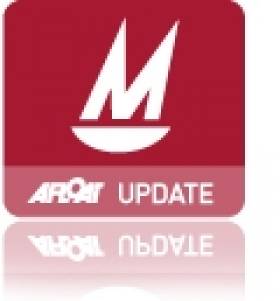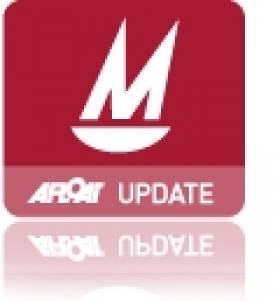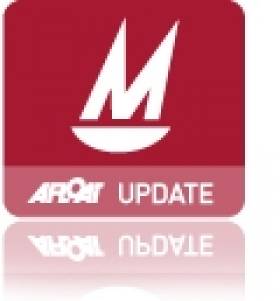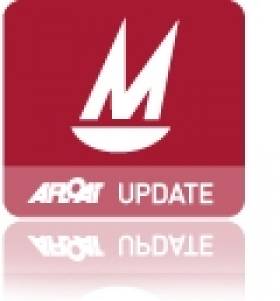Displaying items by tag: Mirror
#mirror – The Irish Mirror Dinghy Association's winter training started this weekend in rather tricky weather conditions. 14 hardy sailors headed out on to Lough Ree in gusts of 20 knots on Saturday morning, under the excellent coaching guidance of Olympic 470 sailor and Mirror Sailing Champion, Ger Owens. The fleet were flying their spinnakers and Ger had them sailing some fantastic tight circles to keep warm and blow out those winter cobwebs. After a short break for lunch a couple ventured out, but some fierce 30 knot gusts came in and with a few young crew in the team it was quickly decided to head back to the warmth of Lough Ree Yacht Club for tactics coaching.
Sunday started at 9am rigged and ready to sail with blue skies and calm waters, then it soon picked up to gusts of 20–knots across the lake and just as quickly dropped to back light winds, heavy showers, then an incredibly thick snow blizzard. Those hardy sailors were having a ball out there, but coaching had to be called off due to poor visibility - they couldn't see the coach or the next mark! A return to base for snow ball fights and hot chocolates completed a rather "fluky" weekend.
Lough Ree Yacht Club (LRYC) host the Mirror training every year, offering free shed storage between training weekends and a warm welcome with log fire and wifi for the parents and essential hot pasta for the sailors. A massive thank you has to go to them for their support of the Mirror coaching.
The professional coaching by Ger Owens there each year really helps the Mirror sailors to develop their racing skills and the young sailors look forward to it extending their sailing season. Everyone is welcome and the storage facilities provided by LRYC for the boats makes training more accessible for sailors throughout the country and it less wear on the boats from travelling.
Is Being an Olympic Sport Good for Irish Sailing?
#olympicsailing – Water Rat's article: Is ISAF Alive To Sailing's Survival As An Olympic Sport? has raised the issue about the future viability of the Olympic sailing movement and brought reaction from readers, including Midshipman, who says it begs two interesting questions:
· Is being an Olympic sport good for sailing?
· Why have the amazing advances we have witnessed in technology over the last 15 years not made sailing more accessible and less expensive?
With the exception of the Laser (a manufacturer controlled boat which is not cheap at €7,250), none of the boats used in the Olympics are to be found in mainstream sailing.
The explosion in sailing during the 60's and 70's was fuelled by the development of exciting low cost boats built, mainly by amateurs, in plywood using new adhesive and coating techniques.
The turn of the century has seen vast improvements in the technologies used in boat building, making boats lighter, faster, stronger safer, but certainly not cheaper, as amateur construction can no longer compete with the sophisticated techniques of the boating industry.
That is probably why the most popular dinghy class in the world remains the inexpensive and simple Sunfish while low tech Hobie Beach Cats still dominate the multihull scene.
In years gone by, most young sailors got their start in wooden Optimists, often built by enthusiastic parents at modest cost over a couple of weekends and then typically graduated to a home built Mirror or its equivalent for their first experience of multi crewed sailing with multiple sails.
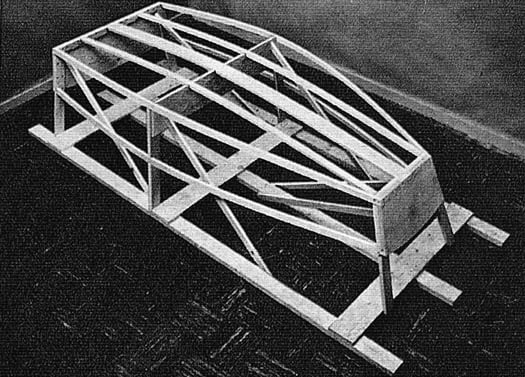
A wooden framework of the early Optimist dinghy
Nothing less than a relatively expensive Glass Fibre Optimist will do now and the Street Cred of young people is dependent on graduating to costly Lasers and 420s. In Ireland this situation is also compounded by the sense of failure youngsters experience if they fail to qualify for one of the Academy or Elite development squads which currently involves over 100 youth sailors of varied abilities.
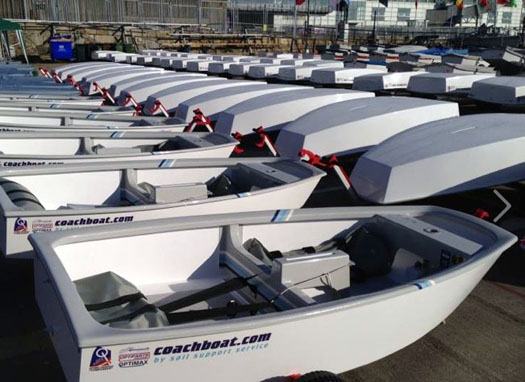
The scene today – charter boats used at Dun Laoghaire for the 2014 Optimist Europeans
Sailing has become so fixated on exciting performance and elite achievement that it has lost sight of the sheer enjoyment of messing about in boats at modest cost which is the principle attraction to the vast majority of people.
We all admire the highly skilled and motivated sailors who aspire to the ultimate Olympic challenge, but let's face it , what they do has virtually no relevance to the activities of most recreational sailors. ISAF uses racing formats and boats which are not reflective of the sport in general, largely on the grounds of needing to excite TV viewers.
With the exception of horse riding, sailing is probably the most equipment dependent (meaning most expensive) sport in the Olympics. I am not sure that this is a message which ultimately helps encourage people to become involved in sailing.
If we want to use the Olympics as a marketing opportunity for sailing, we should use inexpensive boats which are used on a widespread basis by regular sailors and only have 2 events each for men and women whilst eliminating the cost of shipping boats by supplying evenly matched equipment.
Olympic sailing has created a very costly industry which contributes little back to mainstream sailing. The costs are truly horrendous as demonstrated by the recent announcement that the ISA is appointing an additional CEO to head up a funding programme to raise a further €2.75m a year over and above the €1m plus it receives from the Irish Sports Council for Irish Elite sailing activities.
Does the Irish sailing community believe an annual level of expenditure of €3.75m on elite sailing provides the best economic payback to the sport in Ireland? If we could replicate what has been done in New Zealand, maybe there is a business case which can be justified.
However, €15m seems an outrageous amount of money to propose spending over an Olympic cycle, which is equal to something in excess of €800 on behalf of each member of the ISA.
Let's make sailing accessible, less expensive and more engaging and use the Olympics as a shop window to remove the elitist and esoteric imagery created by the current profile of existing Olympic classes.
What we are doing at the moment is deluding ourselves into believing that presenting our sport like NASCAR or Formula 1 motor racing will attract new people to buy Ford Mondeos and Fiat Pandas. – Midshipman
#mirrorworlds – In 2013 Father of Mirror World Champions Michael Robinson wrote about Ryan and Michaela winning the Mirror World championships on Lough Derg. Two years later a second title has been won. Here Michael updates the story after victory at Theewaterskloof, South Africa.
I did not know at that time, if the 2013 achievement should be described as a culmination, the end of the story, or just another chapter, but I was asked me to put our family's experiences down in writing, so that they could be shared by others – so I wrote it as I saw it then. This is an account of the relationship between the Mirror Class and the Robinson family...
It seems like a long time ago now, when we first made exploratory steps into junior sailing. Our older children, Kathryn, Ricky and Brennan, had all sailed Optimists without much success and without much sparkle. It must be said that the family was a little impecunious at that time, and their equipment was not the best available, but there was more to their lack of success than just that. There was another undefinable factor. Whether it was apprehension, something a little short of fear, a lack of fun or something deeper, I am not sure, but Optimists just did not cut it for them.
So, we bought an old Mirror.
And, I mean old. We paid R200-00 (about 30 Euros or 20 Pounds) for it. It didn't look great. It had a thirty year old suit of "Fast Sails" made by a company who specialised in the manufacture of tarpaulins. There were copper ring nails (as were used in the construction of the Ark, I am sure) all over the hull. It had clearly been built in the pre-epoxy era, and every seam was shaky.
Ricky and Brennan, then about ten and eleven, set about sprucing it up with relish. They found a half empty tin of swimming pool paint that had the word "polyurethane" somewhere on the label, and we ended up with a reasonably badly painted blue and white Mirror, with really badly blown sails. A strip of duct tape was stuck down the leech to try and encourage some shape in a sail which was decades past its sell-by date.
The South African Junior National Championships that year, were the first where boats other than Optimists and Dabchicks were invited. Brennan sailed the blue Mirror with his little Boskop Yacht Club friend Sean, who still sails with the family from time to time. This regatta was Kathryn and Ricky's last in Optimists.
Ricky and Brennan sailed the old blue Mirror in their first Mirror Nationals at the ages of 11 and 12. They asked whether they could have some new sails to replace the black duct taped leech set, but were told that new sails would only come their way if they cracked the top ten.
Up to this point, our children's sailing had not cost much – but that was going to change!
They did not make the top ten. They finished eleventh. Father heaved a sigh of relief. The cost of a set of sails was going to be pushing what was then a very skinny budget. But they had lost places in one race because a knot that Father had tied had come loose. So, they applied to Mother for redress, and the next thing we knew, there was a nice set of Harry Ellens's best, hanging from the gaff.
Each time they sailed the old blue Mirror, their confidence grew. It was a complete turnaround from the family's experience in Optimists. It seemed that they were making each other brave, and were feeding on each other's enthusiasm. Brennan, the younger, and the less dexterous of the two was the helmsman, with Ricky, the crew and tactician. The combination was a masterstroke. Ricky immediately took on the mantle of the de-facto mentor, while Brennan had the confidence boost that came with holding the stick.
So confident had they become, that one day they approached their father to ask if they could enter the selections for the Mirror Worlds in Tanzania.
With the family's budget just having recovered from the new sails, and with the likelihood of them being selected in the old boat very slim, even remote, and with Mother menacingly watching every move, Father gave the go ahead. After all, what harm could it do? In the unlikely event of them being selected, one could drive from Carletonville to Tanzania with a Mirror on the roof.
(If, you are wondering where Jim found the temerity to insist that I write this all down, it is because he was at that regatta. This was where we first met him. He saw the old blue boat first hand, and has followed the story ever since. Cormac, on the other hand, knew this bunch intimately before he exiled himself back to Ireland – hence his right to know!)
And, lo and behold, they were selected. Theirs was the fifth name to be announced in the team to go to the Mirror worlds. Father sat, awed, not only by his sons' achievement, but also by the apparent dyslexia of the chairman of the South African Mirror Class Association, an Afrikaans gentleman, who kept on referring to Tanzania as Tasmania.
It turned out that dyslexia was not at issue here. And obviously, the decision to school the children in Carletonville was now severely in the spotlight.
"Do you have any concept where Tasmania is? Do you have any idea what this will cost?"
"Dad, it always was Tasmania. You just don't listen properly!"
And again, they applied to Mother for redress. And, again, got it!
This, by the way, has been a recurring theme.
Fuad Jacobs was commissioned to build a new racing Mirror. A stunning looking boat, pretty as a piece of furniture, and christened African Express after the Fireball that Mother and Father had sailed together. Harry Ellens's sails just had to do, the budget would not stretch to new sails as well. The boys got hold of a copy of the book "Mirror Racing" by Guy Wilkins, and spent hours fitting the boat out and setting it up exactly as the book said.
Before they left, in fact it was on the way to the airport, just after Father had handed over the family credit card with instructions to use it in the case of emergency only, that they were given the instruction to meet people and make friends.
The two little boys from Carletonville, on their way to a place on the other side of the world, to compete in a regatta against the best Mirror sailors in the world, were justifiably apprehensive. They asked how he expected them to do that. Father had to think on his feet (as fathers often have to do, I am sure) and the best he could come up with was a vague strategy: After each race, go and find the winner. Shake his hand and say, "We are Ricky and Brennan from South Africa. Congratulations on your win." And see what happens.
After the first race in the pre-world regatta, they went up to the winner and said "We are Ricky and Brennan from South Africa. Congratulations on your win." He said, "Hi. I am Guy Wilkins."
That rather contrived meeting with the author of their sailing Bible, was the beginning of the first of many friendships that this family has built up with really nice people all over the world. Some of them have gone on to do amazing things in the world of yachting, like Olympic representation and world championship medals, and some are just good friends. The Facebook pages are littered with sailing friends from all over the world – all starting with that simple introduction.
Ricky and Brennan did not do badly in that regatta, and sailed one more Mirror Worlds together in Sweden, after which, their weight combination was just too much for the Mirror.
They had started sailing 420s alongside the Mirror, and in fact sailed in three Youth World Championships together, with Ricky on the helm this time. Ricky has become a formidable helmsman, eventually helming the Royal Natal Yacht Club entry to victory in the Lipton Cup. At his side, as tactician was Brennan, an excellent crew, but a very good helmsman in his own right. Not bad for two little boys who just could not make it happen as single handed sailors.
Ryan (nine years younger than Brennan) had his first experience in Mirror Racing at the twenty four hour race at Milnerton Aquatic club, sailing as part of a family challenge, but he was always destined to sail with his hero, Ricky. Kathryn commissioned a wooden hull from Steve Du Toit, South Africa's foremost dinghy builder, and it was game on. She (the boat that is) was stunning, and was christened (in keeping with Ricky's new status of "university student") Mirrorjuana.
Brennan took over sole control of African Express, but Michaela Mae, then only about seven years old, was just too small for the Port Elizabeth worlds. He sailed with young Julian. Ryan got to sail with Ricky.
And that is where the mentorship started in earnest.
Mirrorjuana's history is a little chequered. She was collected from Steve du Toit immediately before the Selection regatta for the Port Elizabeth worlds. Ricky, with Ryan (then about ten or eleven) as his crew, won the selection regatta, with Brennan and Julian close behind. No sooner had the little boat showed its potential, when it fell off the trailer on the way home. The newly acquired boat straps just did not have the same staying ability as the Mirror. So off she went, back to Steve for a rebuild.
The Port Elizabeth Mirror Worlds were interesting. The city had put on her finest clothes for the occasion, the organisation was superb and a whole lot of friends that Ricky and Brennan had made in Tasmania and Sweden arrived. All five of the children were there, so the capacity to make friends was multiplied. With these five interacting with the existing friends from Tasmania and Sweden, and the new arrivals, the family's circle of Mirror friends grew exponentially. One of these friends was Johnny McGovern, who was press ganged into being the South African team coach, for the rather dubious privilege of spending some time with the Robinson family.
Ryan was a little boy. Not particularly athletic, with an air of trepidation about him. The one thing he had going for him though, was his adoration of Ricky. There was nothing that he would not do to earn the respect of his hero.
Brennan, who had always been earmarked as the ship's secretary, remarkably, started to live out his aptitude for tinkering. (One does not perform engineering on a Mirror – one tinkers.) African Express slowly converted into a minor masterpiece of expertly spliced twine on intricate multi purchase gadgets.
It was a great family time. The three students enjoying the pleasures of their young adulthood with the friends that they had built up over the previous years, and the B team, being drawn into that circle when appropriate, and back to the Mom and Dad comfort zone when the going got tough (or inappropriate, as the case may be).
And the transfer of knowledge was well on the way. Ryan hung on to every word that Ricky said. Johnny was amazingly patient and explained endless intricacies that Ryan pretended to grasp. Brennan had an entourage of girls following him, but the most persistent of all was a seven year old, with a haircut that made her look like a mushroom. She stuck to him like a leech, always carrying a piece of line, practicing knots that he was teaching her.
And the results were not bad. African Express around eleventh, and Mirrorjuana around fifth.
Somehow, the Mirror Worlds in Wales sneaked by unnoticed. And with the family budget being as unpredictable as always, it's probably just as well. There may have had to be a call to be made between University Fees and Airfares, and with Mother on the redress panel, who knows where that may have ended.
Ricky and Brennan were now sailing 470s, and anything else they could lay their hands on, and were helping with the training of youngsters in the various junior fleets in South Africa. Kathryn was making a name for herself as a keelboat crew. But when it came to Mirrors, there were some changes in the air.
Michaela Mae declared herself Brennan's crew. There is no certainty about what Kathryn may have thought of her chances of becoming the crew on African Express, but if she had any ambitions, they were shredded by this bold move. She was destined to fill the role of substitute crew
Ricky was now approaching the top of the class as a helmsman, and should have been assessing his chances at a medal at the up-coming Mirror Worlds in Albany. He chose instead, to take up the position that he held when he and Brennan started out, at the front of the boat, and hand the tiller over to young Ryan. This decision was pivotal – and was the cornerstone behind the future success.
Ricky and Brennan's decision to take the time out of their other sailing stuff, to spend time sailing with, and mentoring their younger siblings, was the decisive moment in the development of Ryan and Michaela into a winning combination.
And each had his challenges. Brennan had to help Michaela overcome her fear of heavy weather, and teach a really little girl the skills required to be a successful crew in a World Championship regatta. Ricky had to find ways to instil confidence into Ryan, while transferring to him as much skill and understanding as Ryan could absorb. And this all had to happen against the background of Father's insistence that they always treat each other with respect, and that the sailing always had to be fun.
And each had a different perspective and skill set to pass on. From Brennan, Michaela learnt a passion for knots and splicing, learnt the art of flying a spinnaker, upped her concentrations levels and learned to focus on the job at hand until its conclusion. Ryan learned about intensive helming, boat speed, surfing and sail trim. And both learnt about the art and science of yacht racing, from tactics at the start through to covering up the last beat. With Michaela being three years the junior, she was learning at a slightly more basic level, but there were no excuses made for her youth. She had committed to the plan, and she was held to her commitment.
African Express and Mirrorjuana were duly selected for the Mirror worlds in Albany, Australia.
Then came the curved ball. The family was given the opportunity to sail together in the Cape to Rio race, on a boat lent to them for a case of beer. Common sense said that the Rio Race should take precedence. The budget agreed with the common sense approach, and Father made the proposal that the Mirror Worlds in Albany should be taken off the family agenda.
Outcry!
Again, they appealed to Mother for redress. Again, redress was granted.
So while Mom Dad and Kathryn made ready for the Rio race, Ryan and Michaela set off for Albany in the company, care and custody of their older brothers.
And it worked out well.
African Express, by now an old lady, in a fleet of shiny new glass fibre Mirrors, had a few breakages, one of which was the new aluminium boom, which broke early on in the game, only to be replaced by the original wooden boom, which she still sports to this day. Another was a critical failure to the vang in the closing stages of the event, which resulted in Brennan and his intrepid little crew logging around eleventh overall.
Mirrorjuana, on the other hand, revelled in her new crew format. Ryan was nicknamed "Pocket Rocket", and he and Ricky left Australia well satisfied with their fourth place. And, of course, they broadened their circle of Mirror friends, with Ryan and Michaela bringing a new generation into the circle.
There was a logic developing here. The next step needed to be to set the little ones free to fend for themselves in the Mirror fleet. And so it was that Ryan and Michaela teamed up for the Lough Derg Mirror Worlds.
The build-up was quite hectic, with Michaela sailing her Oppie with some success, and Ryan trying his hand at following in his brothers' footsteps on a 420. Ricky and Brennan were always closely involved in the sailing activities of the younger siblings, notwithstanding their studies, their 470 aspirations and their involvement in what eventually turned out to be a successful Lipton Cup campaign.
As it happened, Ryan and his pal Dominic, were selected to represent South Africa in the ISAF Youth Worlds in Cyprus, which ended the day before the Irish Nationals started. Michaela, in turn, was selected to sail In the South African Optimist team at the African Optimist Championships in Langebaan, which literally started five days after the Mirror Worlds ended.
I am sure that the thought of a new glass fibre Mirror crossed a mind or two. I am sure that the spars and foils were examined with a view to being replaced. I know that the sails were at least three years old. But, the budgetary pressure occasioned by the simultaneous realisation of all these ambitions was clear, even to the youngest of the team.
The Irish Mirror Worlds were going to have to be contended in a seven year old rebuilt wooden boat, with the existing spars, foils and sails.
Nobody even thought of redress. I think that even Mother realised that if redress was granted, it may impact on her chances of accompanying the expedition to Cyprus and Ireland.
Ryan and Dom took a bit of a pasting at the Youth Worlds, and Michaela was on hand to witness the humble pie being chewed, as the reality of just how fierce the competition on a global scale really is, set in.
And that was the reality that they had to face, when they arrived in Ireland. Not the hottest boat in the fleet. No new equipment. Ryan nursing a severely bruised self-confidence, and Michaela watching surreptitiously out of the corner of her eye, to see if he would pick up, or fold completely. And the luggage was lost!
Two things conspired to get things on track during the course of the Irish Nationals. The first was Michaela's indomitable nature. Ryan had no choice but to buck up, and keep up with her as she set them up in the routine that Brennan had taught her. Check every fitting. Check the rake. Foils. Sails. Rig tension. Water in the hatches.
The second was the joy of running into their old friends, and the pleasure of making the acquaintance of a whole lot of new friends. Vastly different from the stiff relationships encountered at the Youth Worlds. Very soon, it was clear that they were in a comfort zone. They were lent gear by people that they had never met before, until the luggage arrived. And they were absorbed into the Mirror community.
By the end of the Irish Nationals, the team seemed to be on track.
They stuck to the concept of the routine for the whole regatta – right up to the last race. A pre-launch routine. A pre-start routine. A post-race debrief chat on the water. A de-rigging routine. And in that routine, they found confidence, especially, when the results started to look good.
In the switchy conditions that prevailed, it was clear that consistency was going to be important, and that conservative sailing was going to be the key. Father thought he had got the three pronged theme of confident conservative consistency embedded in their combined being, when suddenly it became apparent that Confidence had suddenly over taken the other two prongs.
Heading out to the start on the second or third day of the worlds, on a support boat, it was clear, in the distance that the race had just started. An SMS message arrives from South Africa: "Port Start?" Father's response: "Please no!" Rosanna, the pretty driver of the RIB pressed the pedal to the metal, and the rib got there just in time to witness Ryan and Michaela crossing the entire 91 boat fleet on port in 20 knots of breeze. Clearly, the Mojo had been found.
The rest, as they say, is history.
This is an interview done at that time....
Question: At what point did you realise you had victory in the bag?
Ryan Robinson: We went into the last day with all to play for. Three points ahead of second (the "Philippinos"). Luckily we were discarding a 9th and a 10th while the Philippines Team were discarding a 33 and a DNC. We managed to beat the Philippines Team in the second last race by a few places.
Then the last race came with a few boats being black flagged and... We were one of them!
This meant that if the Philippines Team won the last race, they would get the title. While leaving the race area, with our tails in between our legs, a friend of ours, sailing for Ireland, came past us and screamed "Guys you've won, the Philippines also got a black flag!"
As true as Bob, he was right!
Michaela jumped straight into the water, and a feeling of total relief flowed over me. Then total elation!
And if there was any disadvantage to sailing the older wooden boat, it was not evident. Mind you, it must be noted that Ricky and Brennan were meticulous in the way they looked after and stored the Mirror equipment, and ensured that Ryan and Michaela followed suit, which had the effect of enhancing the longevity.
From the earliest days, when Brennan helmed, and Ricky crewed, it was clear that a proper team had at its disposal the sum of the intellects of the crew members, as opposed to the intellect of the skipper supplemented occasionally by snippets that he allowed from the crew. It seems that when this teamwork is supplemented by the transfer of knowledge, skills and experience by way of both deed and word, that anything is possible.
And that, I hoped, was the story that Cormac and Jim wanted me to record.
Of Mirrors and mentorship.
It was a special moment, and one that needed to be savoured, because moments like that are hard to come by.
In that conclusion, I asked: "Was this the end of the story? Or just another chapter? Does logic dictate that Ryan will be crewing for Michaela at the Mirror Worlds at Theewaterskloof?"
Time, no doubt, would tell. And it surely did.
After the Irish dust had settled, Ryan had 420 things to do. There was an ISAF Youth Worlds coming up, and all his focus went in that direction. Michaela decided that she would be comfortable on the helm of the Mirror, and press ganged Kathryn (the substitute crew) into service. With the confidence that came from having her indomitable sister with her, and under pressure to impress her other siblings, Michaela won the next South African Nationals, and then proceeded to sail almost everything she could lay her hands on for the next few months.
Mirrorjuana was neatly packed away, ready to be called back into service at a moment's notice.
It must have been a rush of blood that caused Father to buy Ciao Bella – the 35ft Simonis that the family had sailed to Rio from Cape Town, just after the Albany Mirror Worlds. That race was on again, and the family was all still young enough and keen enough to give it another bash. Dinghy sailing had to fit in with the refurbishment and preparation for the Rio race.
It is important to tell about the second Rio race, when discussing mentorship, because Ryan and Michaela were older and more mature the second time around. And the race was a lot more difficult.
This is part of what Mother wrote after the race:
"The fierce start of the race tested not only the boat and the abilities of the crew, but also the fibre of what holds a family together. Fifty knots of wind and fifteen metre swells, with horizontal rain and foaming crests should leave a memory of fear and dread. For me though, the memory is of the oldest three taking control of the situation, and moving into the decision making role on the boat with a level of confidence that did not countenance fear from their younger siblings. The memory is of the younger two finding their sea legs and being inspired by their elders – of moments of quiet words between Ricky and Ryan, of Brennan taking Michaela on deck on the second morning and leading her through processes involved in sailing in really heavy weather, and of Kathryn setting the example by simply being indomitable."
The 22 days together at sea, directly and unconsciously absorbing skills from one another cannot be overlooked or underrated.
And it was during that trip that it became clear that Michaela was ready to take the helm – if Ryan had what it took to be her crew!
Ryan could be described as a cerebral sailor, whose intellect it supplemented by his tenacity and quiet perseverance. Michaela has been described as feisty and is a bit of a firebrand. Two more different characters you could not wish to meet. And the old rule was still in force, no matter how difficult compliance may seem. It all had to happen against the background of Father's insistence that they always treat each other with respect, and that the sailing always had to be fun.
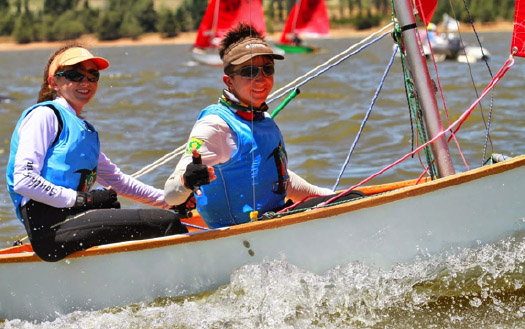
Michaela and Ryan in South Africa. Photo: courtesy Trevor Wilkins
There was a tight rope that needed to be walked, balancing between Michaela being able to express her skills and independence and Ryan having enough authority in their partnership to ensure that his advice was followed and his skills transferred to Michaela. And there was another little issue – one that very few people who see the brave Michaela face would believe - Michaela was not particularly confident in strong wind.
By the time April arrived, Ryan was in full swing with his preparations for the Youth Worlds but had to climb down from the giddy heights of being the selected 420 helm, to crew for his little sister at the Mirror Nationals and selection regatta at Theewaterskloof. They won the regatta, but there was still a lot of work to do. Sometimes the tensions on the boat were palpable.
Ryan changed focus to the Youth Worlds, and Michaela was asked to crew on the Royal Natal Yacht Club Lipton Cup Challenger which was under the charge of her idol and older sibling, Brennan. But, they kept on getting back together on the Mirror, and slowly, the interpersonal relationships were getting sorted out. Ryan had a debt of honour, based on what Ricky had done in Albany four or so years earlier, and worked hard at establishing a workable relationship.
The two resorted to the tried and tested formula of finding confidence in routine, and added to their existing routine, a post-race moment when any harsh words said during a race, were addressed on the water before the start of the next race, or before coming ashore. They became very open about their disagreements on the water, and discussed the disagreements with both parents and the siblings, invariably ending the explanation with words like: "But we have talked it through and have apologised to each other on the water."
As the Theewaterskloof Worlds came closer, so the Mirror sailing became more intense. The two went off to Theewaterskloof to spend a week practicing while Brennan was sailing the inter-varsity regatta at the same venue. Ricky and Brennan had acquired a 505, and sailed their first regatta in this class at the Theewaterskloof leg of the regional Grand Slam series, part of the Mirror build up.
And Ryan and Michaela lost in that same event, to the Vivier twins.
It had been a while since anyone in the family had been beaten in a Mirror class regatta, and, the reminder that the Vivier boys are a class act, and the fact that they would be joined at the worlds by a few other top South African teams, made it clear that some additional preparation was going to be required. And, a strategy was needed to cope with the build-up of pressure that came with the expectations that surrounded the concept of "defending champions."
The strategy was two-fold. Firstly a step back from the Mirror for a while – with Ryan and Michaela sailing separately in the Youth Nationals. Michaela sailed a 420 with her friend Benji, who, I am pleased to report did not require counselling after the experience. Ryan sailed a Dabchick, and won the trophy that his mother had won 40 years previously, and which his hero Ricky had won 10 years earlier. For them it was a low pressure social regatta, sailed at a familiar venue and amongst friends that they had built up over all their years of sailing.
The second leg of the strategy was a little more complex. Based on the ineptitude of their parents, the initial family goal in any regatta was half way up the fleet. This became known as the Wanker Line. Because there was a secondary goal to winning at any event, the pressure to win was reduced, and the emphasis could be on enjoyment, with the Wanker Line target providing just enough pressure to keep the competitive juices active.
Following that train of thought, and assuming that consistency was going to be key to the successful completion of the regatta, the decision was made to establish a consistency quadrant – the position in the fleet that needed to be achieved consistently, in order for a bit of luck at the right moment to bring about a happy outcome.
So, the word "win" was dropped from all conversation, and "consistency" became king.
A quiet Christmas at home, with all the family there – some words of wisdom from Ricky and Brennan, and off we went. Mirror on the roof. Holiday 23 behind. And Kathryn on hand as the main support.
I said when writing about the event in Ireland a few years before, that they had experienced "the joy of running into their old friends, and the pleasure of making the acquaintance of a whole lot of new friends." This was absolutely true again at Theewaterskloof. Very soon, again, it was clear that they were in a comfort zone.
And the mentorship took another turn. Ryan and Michaela set about setting up their friends' Mirrors to all the settings that the family had worked out over the years. Very soon, there were a whole number of boats set up to the same rake, rig tension and sail settings as Mirrorjuana.
The pre-worlds started with a stutter, and a bit of a squabble on the water – and the inevitable disappointing result. The routine kicked in. The harsh words were discussed in the post-race moment, and the issues were addressed. In race 2, the mojo returned, and the first win of the event was recorded. The consistency quadrant was set at 7, and was achieved in every race. Even though the wind was heavy for most of the races, Michaela did not baulk – the team seemed fine in a strong South Easter.
But things were still not settled. Michaela offered Ryan the helm, with the explanation that this may be his last Mirror Worlds. Ryan offered to drive, to take the pressure of expectation off Michaela's shoulders. And when talk started about the superstition that a win in the pre-worlds spelt disaster for the results in the main event......
There were moments of deep conversation with Kathryn, and a number of quiet calls to Ricky and Brennan – and who would helm in the Worlds was all up in the air until the morning of the last races of the Africans.
Ryan said simply: "We have come this far with this plan – we must just see it through."
With that settled, all the routines in place, and the consistency quadrant system ostensibly working, they had a great last day, and ended up winning by 4 points from their closest rivals and close friends, with the Vivier boys looming large in third place.
With the New year celebrations done and dusted, and a lay day spent exploring Cape Town with the Bellfield family, the emphasis moved on to the Worlds.
And there were a few new challengers in the mix – some serious South African hot shots had joined the fray.
The need for calm was clear. Shelter was found in the established routine
The consistency quadrant was set at 9. Easy meat – no pressure.
The routine kicked in at 07h00 each morning, with a run and a stretch and a strategy chat with which ever South African participants wanted to be there. The breakfast and on the water snacks and drinks preparation routine became rigid. The boat check and rigging routine became as much a shield against pre-race conversational pressure, as it was a method of ensuring continuity of performance. The pre-start routine and the post-race routine were followed with almost religious fervour. And the more items that were included in the various routines, the less variables there were to deal with in the racing, and the calmer things became.
And the routine worked right from the beginning. The first two races saw huge disparities in the positions achieved by the leaders of the Africans/Pre-Worlds. Mirrorjuana's 4 and 1 compared comfortably to the Australian 16 and 12, the GBR 1 and 14, the GBR 9 and 5 and the Vivier Twins 17 and 2.
And it looked like the consistency quadrant, set at 9, was doing the job of taking performance anxiety out of the equation
But, there was more to it than that. In many of the races Mirrorjuana rounded the first weather mark well outside of the consistency quadrant. Somehow, the two always found the tenacity, tactics and technique to get back into contention. Even when Michaela was sailing with a fever, they managed to stay within (or in one case very close to) the magical number 9. The consistency meant that one DNF, due to a main halyard failure, could be discarded, and that they effectively won the regatta with a day to spare.
Of course this records many of the things that a father could hope to see in his children. Tenacity, courage, commitment, siblings working together, grace, friendliness and all the good things which are a source of pride. But, more and more, I am starting to see the point made by Jim and Cormac and more recently by Grant.
The value of sailing as a family activity needs to be emphasised, as does the value of family in the sport of sailing. Mentorship as a method of transferring knowledge, (not necessarily even only in sailing), needs to be revisited.
But mostly, it is important to record the friendships made and the joy experienced in this very special sport – and the role that this very special little boat has played in those friendships and that joy.
Sligo Yacht Club Refurbishing Old Mirror Dinghies
#sligoyachtclub – An interesting winter project is under way in the training room of the new Sligo Yacht Club building. A group of enthusiasts are refurbishing a collection of 10 old Mirror dinghies.
It began with a walk around the dinghy park and the adjacent area to gather and requisition any abandoned boats. These, and others donated by kind "empty nesters" who wanted the space in the garage back are being stripped down and rebuilt to address the ravages of age and neglect. As we study the elderly ladies and compare one with another it is fascinating to see previous repairs, some brilliantly carried out and almost unfindable, other less so, but all are records of collisions and incidents of long ago. We amuse ourselves trying to work out what happened and who was right.
Subtle variations in the boats also come to light – odd changes in the rocker curve, narrow bow transoms, stiff gaffs, bendy gaffs- all little tweaks by sailors (or their parents) bending the rules to gain some little advantage in the Darwinian jungle that was the Mirror fleet of the 1980s and 1990s. Who did them and did it work?
This experimentation, which was widespread (if not quite kosher) was part of what has produced great sailors from the fleet of the time. That gaff rig was a bitch to get right, but brought so much learning. Is tweaking the boat not a skill that any truly successful sailor is going to need? So much is lost when boats all come from the same mould and each is the same as the next.
There is life in the old wooden Mirrors. The 2013 Words at LDYC and the 2014 Nationals in Sligo were won in wood. Sligo will be using the restored fleet for its sail training and Women-on the-Water programmes. Some of the better boats may be given on season-long loans to promising youngsters that do not have their own. It is great to get them back into order, and the work is deeply satisfying.
This must be a way to revive Irish sailing. It is guessed that there must be 500 Mirrors waiting for their day to come again. No-one really knows the number, but its big. Mirrors old and new have one incomparable advantage over the many other designs that have come and gone in the 50 odd years since they were introduced: Children seem to love sailing them.
South African Mirror Siblings Defend Mirror World Championship Title First Won on Lough Derg
#mirror – Eighteen months ago brother and sister Ryan and Michaela Robinson, from Boskop Yacht Club in Carletonville, approximately an hour's drive outside Johannesburg, won the Mirror World Championships hosted by Lough Derg Yacht Club.
They won against competition from the Philippines, GBR and Irish crews among others. Fireball correspondent for Afloat, Cormac Bradley, raced against and worked for their father, Michael, during his time in South Africa and after the regatta in Lough Derg, Michael wrote a piece on the campaign to compete in the Irish hosted Worlds. The essence of Michael's article is that it isn't necessary to have the latest boat and sails in order to win a Worlds and he chronicled how the family had engaged with the Mirrors from a relatively modest investment of time and money to a full blown Worlds campaign.
The article obviously struck a chord because on revisiting the story on the Afloat website recently, it had received over 5,000 reads!
So, as a follow-up to that widely read article, Bradley reports that Michaela and Ryan successfully defended their Worlds title, but with their roles in the boat reversed, Michaela helmed and Ryan crewed.
This time the strongest threat to the defence came from a concerted British team which had a number of combinations finishing at the top end of individual races. However, Michaela and Ryan were able to defend their title with a race to spare! The 2015 Worlds were held in Theewaters Kloof Dam outside Cape Town. Regrettably, there was no Irish presence at the 2015 Worlds.
A full review of the double win by the Robinsons has been posted HERE.
No Irish Mirrors To Contest South African Dinghy Worlds
#mirror – After a successful staging of the Mirror dinghy world Championships on Lough Derg in August 2013 the biennial championship is underway again this week but this time at a South African venue and sadly without any Irish boats racing.
After four races sailed the home entry Mirrorjuana sailed by defending champions Michaela and Ryan Robinson are leading after a long postponement to allow winds to settle.
Two years ago the Lough Derg Yacht Club championships attracted 91 boats from seven countries. This week the Theewater Club hosts have an entry of 59–boats from five countries, including single entries from France and Japan.
Having won the 2013 Worlds in style the African Mirror Champs Recalled their Lough Derg Victory for Afloat readers here.
The next big event on the Mirror dinghy calendar will be the UK Mirror National Championships from Saturday 15 August 2015 to Friday 21 August 2015.
The event will run alongside Abersoch Mirror Week and be hosted by South Caernarvonshire Yacht Club on the Irish Sea.
2015 Sailing Calendar Includes Two Bicentenaries & Ireland's Biggest Regatta At Dun Laoghaire
Irishsailing – After the remarkable across-the-board success of the 2014 Irish sailing season, 2015 will have to be very special indeed to be remembered with such enthusiasm. But it's a special year in any case, as two major sailing Bicentenaries – one in the Irish Sea, the other in the Solent – will have added and poignant meaning, as the Centenaries a hundred years ago could not be celebrated because of the First World War.
As for Irish sailing generally, life moves on, there are new sailors on the water, successful young sailors are graduating to the next stage of their rapidly developing careers, and established stars continue to plan fresh campaigns, for sailing is indeed a sport for life.
Then too, new fixtures successfully introduced in 2014 will require nurturing, tuning and encouragement if they are to fulfil their potential in the coming year, while at the same time there's always extra effort needed to give proper support to established fixtures, which have to live with the reality that they might wilt through being taken for granted. Both new and longer-established boat classes will need continued enthusiastic involvement, and our well-loved classics and traditional craft must be cherished and sailed, for lack of use is the real enemy of boats, whether old or new.
As for the major administrative initiatives introduced in 2014, they will need constant monitoring, but deserve full support from the sailing and boating community at large, for it was in response to a grass-roots initiative that the radical and very necessary reforms of the Irish Sailing Association were undertaken. Those appointed to undertake the root-and-branch reform of the national authority have done so with commendable dispatch, so it is now the duty of the rest of us to support their continuing efforts. And we can best do that by enjoying our boats and our sailing and time afloat in its myriad of interests, while encouraging others to do the same. W M Nixon outlines on what the coming year may bring.
One thing at least is certain for the coming season afloat during 2015 in most of Europe. It will not mark any significant sailing Centenaries. Instead, we are immersed in four years of remembering the Great War of 1914-1918 a hundred years on, with all the added twists of that period's longer historical narrative in Ireland. In such a context, it may seem frivolous to point out that sports like yachting have no great Centenaries to mark at all in 2015. But this minor off-screen fact is a reminder of the all-involving horror and obscenity of total warfare on an industrial scale. It obliterated anything like normal life.
Yet as recreational sailing had been going on in some sort of organised form for hundreds of years – albeit in a fairly rudimentary way in its earliest years in the 16th Century – there may well have been several important dates to be marked during the time of the Great War itself, but they were allowed to pass as there was no sport afloat, while civilian life ashore was very subdued.
And in Ireland, with the Troubles persisting for four years after the end of the Great War until 1922, the Bicentenary of the Royal Cork Yacht Club in 1920 was to be a muted affair – the official History of the Royal Cork Yacht Club (published 2005) tells us: "Plans for a special dinner to celebrate the club's bicentenary in 1920 had to be cancelled, probably because of the disturbed conditions in the country"
So the idea of celebrating the Centenary of the Royal Yacht Squadron in Cowes in 1915 at the height of the international war - other than in a rather solemn shorebound way - would have been unthinkable. But that in turn fuels the celebrations when the peacefulgood times roll again. Thus the Royal Cork Yacht Club, having been unable to celebrate its Bicentenary in 1920, went on to have a fabulous two-year Quarter Millennium celebration in 1969-70. And as the RYS couldn't have a proper party in 1915, there's no doubt that the up-coming Bicentenary in 2015 will be the nucleus of international sailing's megafest-of-the-year.
There are of course several clubs which pre-dated the Squadron when it was founded in 1815. And there are many whose members outshine the small membership of the RYS in the breadth and energy of their sailing. But for 2015, let's just acknowledge that the prestigious Squadron has been at the heart of sailing history for a very long time, while their clubhouse's location right on the Solent at Cowes is so central that when any great Solent-related events are under way, the Squadron is in the middle of the story.
Thus it was on the Squadron lawn that in July that the Irish team celebrated their epic Commodore's Cup victory at the end of July 2014. And it will be towards the Squadron and its Bicentenary that the fleet will be racing in 2015's west-east Transatlantic Race. And then it will be the firing of the cannons from the historic Squadron battery which will signal the start of the 46th Fastnet Race on 16th August 2015.
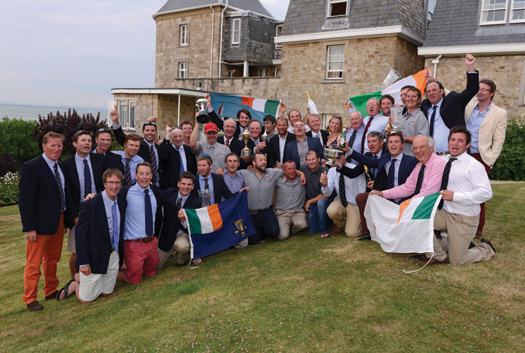
Party time at the Royal Yacht Squadron – the Irish team and their management gather to celebrate victory in the Commodore's Cup at the Squadron Castle in Cowes on August 1st 2014
There'll be many Irish boats involved, and the best-placed of them at the finish will be the winner of the Gull Salver, currently held by Martin Breen's Reflex 38 Lynx from Galway Bay SC, which was skippered to success by Aodhan FitzGerald in 2013's race. It's a coveted trophy, instituted to honour the memory of Harry Donegan of Cork and his famous cutter Gull, which was one of seven boats which inaugurated the Fastnet Race in 1925, and placed third. Since then, Irish Fastneteers have frequently been in the great race's top places, and best of all was in 2007 when Ger O'Rourke's Cookson 50 Chieftain out of Kilrush, sailing under the burgee of the revived Royal Western of Ireland YC, came sweeping in to the finish line at Plymouth to win the Fastnet Race
overall.
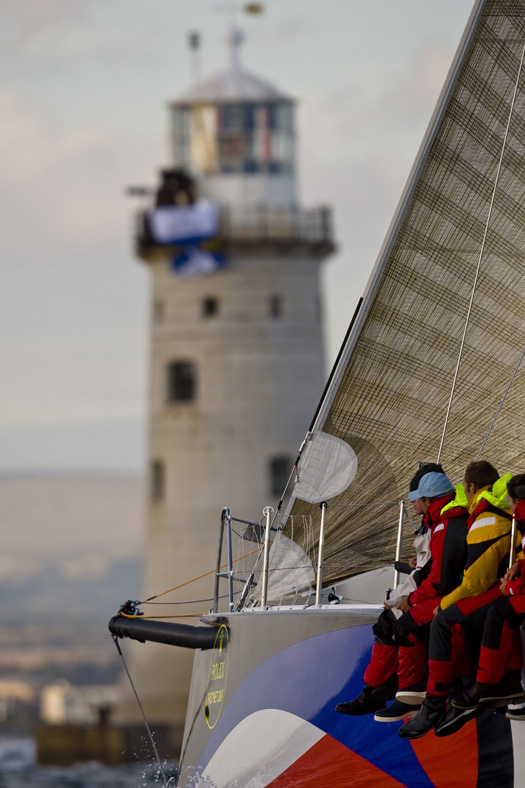
One of the greatest moments in Irish sailing history – Ger O'Rourke's Chieftain sweeps towards the finish line to become the overall winner of the Rolex Fastnet Race 2007. Photo: Rolex
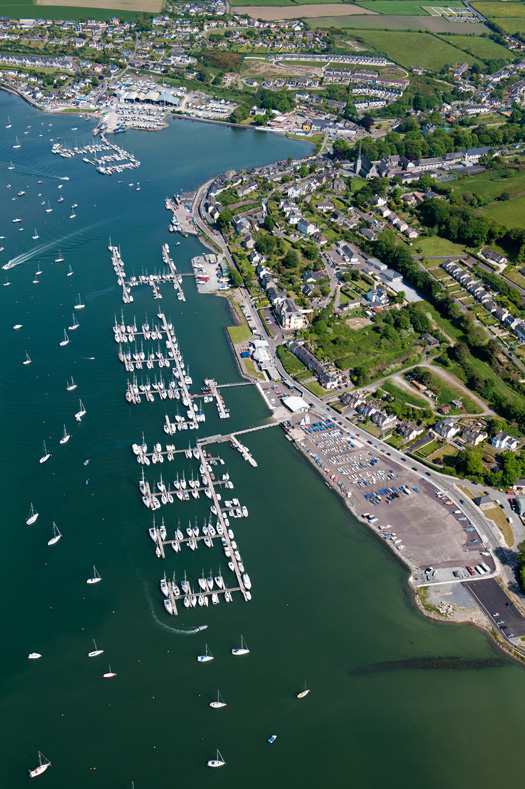
Just the spot for a great Tricentenary celebration - the very complete sailing facilities provided jointly by the Royal Cork Yacht Club and Crosshaven will become a world focus in 2020 with the Club's 300th anniversary. Photo: Bob Bateman
The realisation that 2015 sees this significant RYS Bicentenary is a timely reminder that the Royal Cork's Tricentenary is only five years down the line. They're five years which will be gone in a flash, and already behind-the-scenes moves are afoot to ensure that the national sailing programme will properly facilitate the extraordinary anniversary being celebrated in Crosshaven in 2020.
But meanwhile other Irish sailing centres have their own regular programmes to operate in the intervening four years, and in terms of numbers and scale there's no doubt the top event in Ireland in 2015 will be the biennial Volvo Dun Laoghaire Regatta from 9th to 12th July.
Anyone – and there were many - who took part in this unique "suburban sailfest" in 2013 will know that the VDLR has come of age. It's an event which is comfortable with itself while at the same time being always in development and evolution mode. Each staging of this remarkable Dublin Bay happening sees lessons being learnt and implemented even while the multi-class racing is under way on several courses. And in the two year gap before the next staging, the experience gained is closely analysed and the programme refined to further improve the sport in every area.
You get some idea of the sheer depth of racing experience in Dun Laoghaire by noting that the Chairman of the 2015 Committee is Tim Goodbody, with Martin Byrne as Vice Chairman while the Race Director is Con Murphy. And those three sailing megastars are just the peak of a mountain of race administration experience which is being drawn in from all over Ireland to ensure that the fleet of 400-plus boats gets the best sport possible.
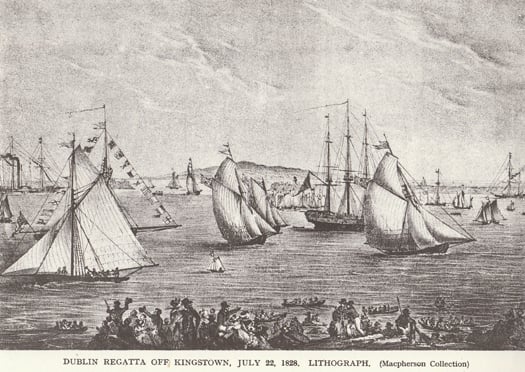
The first regatta in 1828 at the new harbour at Dun Laoghaire, which will be the setting for Ireland's biggest event in 2015, the Volvo Dun Laoghaire Regatta from 9th to 12th July.
While there'll be keenly participating boats from all over Ireland as well as Scotland, England and Wales, the setup of Dublin Bay being right on the city's doorstep means that it's the locals who would pose an administrative problem for a less experienced team. As the dates for the VDLR approached in 2013, the weather forecast steadily improved, and thanks to the Regatta's "extra long weekend" format, the sudden arrival of summer meant that a host of boats from the greater Dublin area came in as last minute entries, their owners and crews managing to scrape the extra day-and-a-half needed off work. It's a scenario which would put an overstretched administration off course, but the VDLR team took it calmly in their stride, and the result was a successful summer festival of sunlit sails and great sport, with maybe two thousand taking part.
This year there's a more structured cross-channel involvement, as the venerable Royal Dee YC in Cheshire has leapt to life to celebrate its Bicentenary. Founded as the Dee Yacht Club in 1815 with the end of the Napoleonic Wars, it didn't get the Royal seal until 1947, but nevertheless claims to be older than the RYS. With growing fleets in North Wales and the Mersey, it has put together a Bicentennial Royal Dee Irish Sea Offshore Championship linked closely to ISORA, which will bring the fleet across to Ireland to take in four offshore day races sailed as part of VDLR 2015.
Irish National Championships which will be part of the VDLR 2015 programme include the J/109s, the RS Elites, the Beneteau First 21s, and the Wayfarers, while the Leinster GP 14 Championship is also included as an integral part of the Regatta.
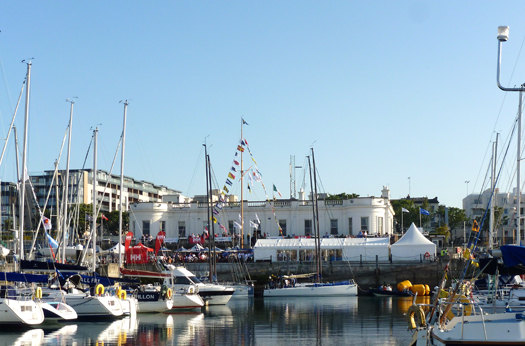
Party time in Dun Laoghaire – the Royal Irish YC during VDLR 2013. Photo: W M Nixon
As for Ireland's classic clinker-built vintage classes, one of the pleasantest surprises in VDLR 2013 was the large turnout of Mermaids, which had superb racing on the course area in the northwest corner of Dublin Bay. Despite having been born as the Dublin Bay SC Mermaid in 1932, this class of 17ft super-dinghies is no longer included in the regular DBSC programme owing to shortage of numbers for weekly turnouts. But it seems that as far as the VDLR is concerned, the Mermaid is now an event boat, and the fleets still thriving at other centres, together with some of the dormant Dublin Bay craft, bestirred themselves for the four days to enjoy good sailing for more than three dozen boats, something which is highly likely to be repeated in 2015.
The even more venerable Water Wags, founded 1887 with the current boats dating from 1903, continue to thrive in Dun Laoghaire, and the word is they expect to have at least twenty boats in action, while another wooden classic, the Mylne-designed 25ft Glen keelboat, is 50 years and more in Dun Laoghaire, and looks forward to having at least twelve boats racing in 2015.
All these specialized and historic classes are in addition to the numerous cruiser-racers which continue to be the backbone of Dublin Bay sailing. And while many of them will see the VDLR 2015 as a highlight of the year, in turning to consider the overall national programme, we find a sport which is shaking off economic recession to get on with an extraordinary plethora of local, national and international sailing events.
The problem is that most events of significance hope to locate themselves in the peak sailing period from late May to early September, so clashes are almost inevitable, and if you're interested in several different kinds of sailing, the overall choices can be bewildering in their complexity and logistical challenges.
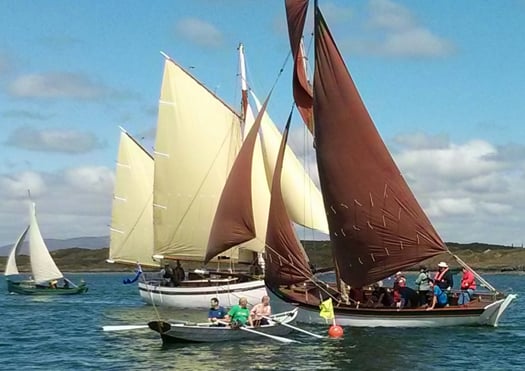
The Baltimore Wooden Boat Festival attracts an eclectic fleet – included here are a Shannon Gandelow, a West Cork Mackerel Yawl, the ketch Sile a Do, and an Heir Island Lobster Yawl (left).
For instance, the variety of events now available for the traditional and classic boats – usually but not necessarily under the Old Gaffer umbrella – would keep anyone busy for most of the summer. It starts with the Baltimore Wooden Boat & Seafood Festival from Friday 22nd May to Sunday 24th May, which you'd think very early
in the season for someone faced with fitting out an old wooden boat in Ireland's climate, but somehow they do it.
Then on the East Coast for the early summer Bank Holiday Weekend from May 29th to June 2nd, there's the Old Gaffer gathering in Dublin Bay at Poolbeg Y&BC with the annual race for the Leinster Trophy in the bay on Saturday May 30th, the event then morphs into the Dublin Port Riverfest in the Liffey on Sunday May 31st, and finally it all concludes with the race for the Asgard Trophy back in the bay on Monday June 1st.
The annual Lambay Race at Howth, a regular fixture since 1904, has seen its course becoming increasingly complex in modern times in order to satisfy the desire of modern racers for competition on every possible point of sailing. But in 2014, to celebrate the Centenary of the Lynch family's Echo, the venerable Howth Seventeens were sent on the traditional course north from Howth Harbour through the sound inside Ireland's Eye, then on round Lambay leaving it to port, and then back south inside Ireland's Eye again to the finish at Howth pierheads.
This was such an attractive proposition for Old Gaffers and Seventeens alike that on the day an extra Classics Division was added to cater for ancient craft, and it hit the spot. This option will be offered again for 2015's Lambay Race (it's on Saturday June 6th), and the word is that Dickie Gomes's 1912-built 36ft yawl Ainmara will be coming down from Strangford Lough to defend her title after 94 years. 94 years? Yes indeed - she won the Lambay Race in spectacular style in 1921 when still under the ownership of her designer-builder John B Kearney.
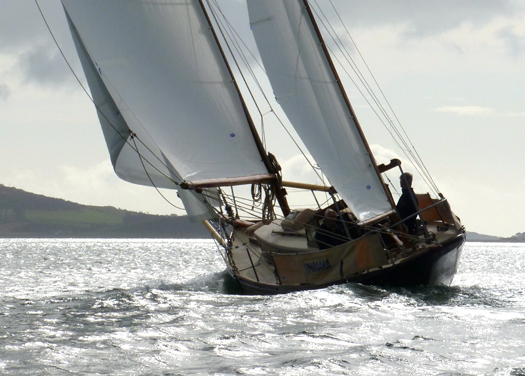
After 94 years, Dickie Gomes's 36ft 1912-built yawl Ainmara (seen here on her home waters of Strangford Lough) hopes to return to defend the title in Howth's Lambay Race, which Ainmara won in 1921 while still in the ownership of her designer-builder John B Kearney. Photo: W M Nixon
The Old Gaffers attention then swings north as the Tall Ships are coming to Belfast from Thursday 2nd July to Sunday 5th July. This is going to be a serious biggie with those ships already signed up including a significant turnout of Class A vessels, which are square riggers and others of more than 40 metres in length. Belfast Lough lends itself particularly well to the Parade of Sail which follows a Tall Ships gathering, and in 2009 when they were last in the port they put in in a virtuoso display with the Dutch ship Europa in particular going to the trouble of getting herself over towards Whiteabbey in the northwest corner of the lough to allow her time get every stitch of sail set before proceeding seawards down-lough in colossal style, a much more impressive display than we've become accustomed to in Dublin, where the shape of Dublin Bay is such that it doesn't really provide the space for square riggers to set all cloth before getting out to sea.
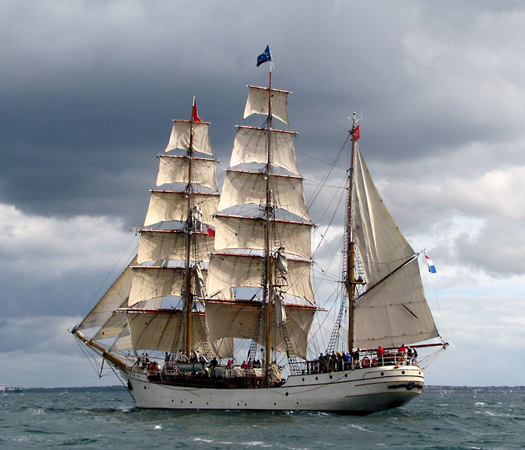
The Tall Ship Europa shows how it should be done in Belfast Lough in 2009, taking time out to set full sail before she starts to gather power to make the proper input into the Parade of Sail.
Like Dublin, Belfast has shown it can be hospitable to Old Gaffers, and it was a very welcoming main port during the OGA Golden Jubilee Cruise-in-Company in 2013, so for 2015 the OGA National President Sean Walsh hopes to up the ante by persuading his members from all round the Irish Sea to gather in Belfast, and to add spice to the mix, he hopes to persuade the Howth 17s to put in an appearance as well, to sail with local one designs like the 1903 Belfast Lough Waverley Class, which have been experiencing a revival in recent years.

Old Gaffers in Belfast for their Golden Jubilee in 2013. The Irish Sea classic and traditional fleet will return to the same venue for the Tall Ships gathering in July 2015. Photo: W M Nixon
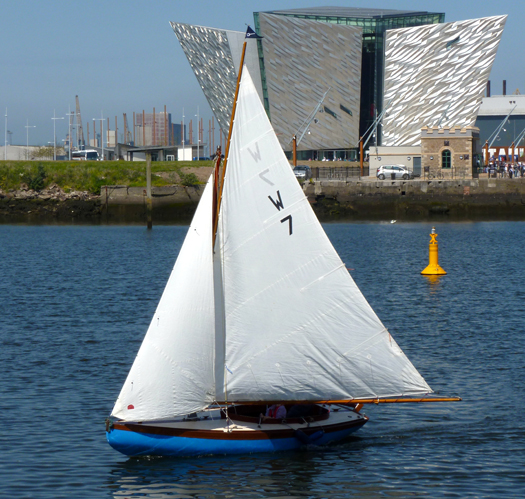
The Belfast Lough Waverley Class Lilias (built 1903) sailing at the Titanic Centre in Belfast. In 2015, the Waverleys will be joined by some of the 117-year-old Howth 17s to participate in the visit of the Tall Ships. Photo: W M Nixon
The Seventeens have made long treks as a class before – in 1998, five of them were road-trailed to Carrickfergus to mark the class's Centenary, with the first five boats built by Hilditch of Carrickfergus. So though they'd trailed there, they then sailed the 90 miles back to Howth, just as the first boats had done a hundred years earlier. Then in July 2003, fifteen of the Seventeens took part in the Glandore Classics Regatta thanks to a brilliantly organised exercise in logistics using a flotilla of low loaders which could take three boats apiece.
For all of Ireland's classic and traditional boats in 2015, and an international fleet too, Glandore is very much up on the radar again, as a special effort is being made by a GHYC team led by Donal Lynch to encourage increased numbers in the CH Marine Glandore Classic Regatta from Saturday July 18th through Friday July 24th. It's a date which certainly allows Old Gaffers plenty of time to get down from Belfast, indeed some may even consider the option of making the voyage northabout to take in a round Ireland cruise while they're at it. And as that great magnet of the Irish Sea classic and traditional scene, the Peel Traditional Boat Weekend, isn't until Friday 31st July to Sunday 2nd August, it's just about possible to factor that in as well.
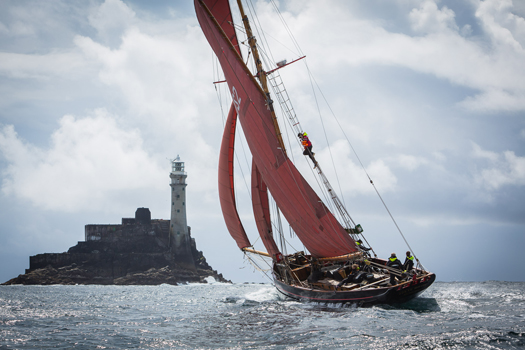
Everything happening at once – the famous Pilot Cutter Jolie Brise was the star of the Glandore Classics in 2013, and as it was her own Centenary she celebrated by sailing round the Fastnet Rock – she has been a successful Fastnet Race participant several times. Photo: Brian Carlin
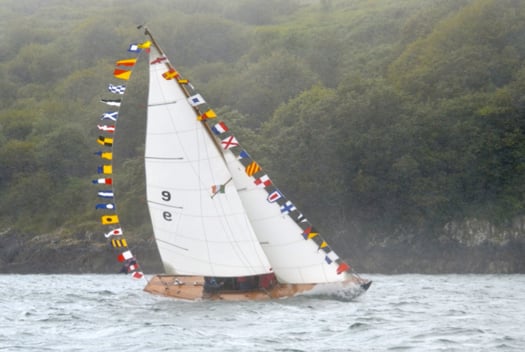
The Glandore Classics attracts an international fleet, and 2013's regatta included a class of Fife One Designs from the Menai Straits, all of them keen to party and showing it. 2015's Glandore Classics is from July 18th to 24th. Photo: Cormac O'Carroll
All this is already happening for the oldies with August barely under way, yet for modern cruiser-racers the potential programme for any keenly-sailed Irish boat is equally complex, attractive and challenging. The season starts as usual with the Scottish Series from Friday 23rd May to Monday 26th May – there'll probably still be snow on the mountains of Arran. They've gone back to their roots by starting with a feeder race from Gourock to the main regatta centre at Tarbert on Loch Fyne. "Going back to the roots" is something of a theme for this year's staging of the Clyde Cruising Club's main racing event, as this is the 40th Scottish Series. Come to think of it, there are so many important 40th anniversaries happening in sailing these days that we have the admit that the decade which brought us the full horror of wide lapels and flared trousers also contributed some lasting elements of the international sailing scene, indeed it could be said that the modern era in sailing really began about forty years ago.
Back in Ireland, the ISORA programme will be well under way by June, while the Lambay Race on June 6th can be looked at with more interest by several boats, as the biennial National YC Dun Laoghaire to Dingle Race doesn't start until Friday June 12th . Last time round, there was a total fixtures clash between the two events, but in times before that hyper-keen sailors such as the Tyrrells of Arklow with Aquelina have been able to fit in both, indeed one year they did it so well they won both too, and were rightly acclaimed as the Afloat "Sailors of the Month" for their success.
For 2015, defending champion in the Dingle Race is Brian O'Sullivan of Tralee with the veteran Oyster 37 Amazing Grace, which came good in the end in 2013 with a new breeze which knocked pending leader Antix (Anthony O'Leary) off the winning perch. But with the 2015 Dingle Race acting as a useful if rather indirect feeder for the Covestone Asset Management Sovereigns Cup in Kinsale from June 24th to 28th, there could be all sorts of sharp boats lining up to take the prize, for the Sovereigns Cup 2015 includes the all-singing all-dancing ICRA Nats 2015.

The welcoming port – Kinsale is one of Ireland's most popular destinations, and in 2015 its hosts the combined Sovereigns /ICRA Nationals from June 24th to 28th.

Perfect sailing – racing in the Sovereigns at Kinsale in June 2013. Photo: Bob Bateman
Yet the timing of the combined Sovereigns/ICRA Nats is such that there's still plenty of time and space to get back to the Irish Sea for the Volvo Dun Laoghaire Regatta 2015 from July 9th to 12th, a reminder that much of the cruiser-racer programme for 2015 is in a neatly balanced and user-friendly timescale for everyone except perhaps those who wish to do either the entire ISORA or SCORA programme as well, so the problem mostly is going to be getting time off work.
And for the hyper-keen cruiser-racers, particularly those whose boats are small enough to be conveniently trailerable, further temptation looms in 2015 with the WIORA Championship at Galway Bay Sailing Club from July 22nd to 25th. For the fleets in the Shannon, on Tralee Bay, and in Clew Bay, it's a bit more than a day's sail away, but they'll be there to challenge Liam Byrne of the home club who won it in 2014 with his Corby 25 Tribal at Mayo SC in Clew Bay, while some top boats from more distant centres are expecting to trail to Galway Bay to spice up the competition.
By this stage of the season a more relaxed pace might be welcome, but the lively turnout of 80 boats in 2014 for the new-style four day Cork Dry Gin Calves Week out of Schull in early August (Tuesday 4th to Friday 7th August in 2015) suggests that for racing sailors, the best relaxation is more racing, but in a holiday setting. And yes, it has been noted that a true West Corkian sailing nut could indeed do all of Calves Week 2015, and still be on the Squadron line for the start of the Fasnet Race nine days later.
For dinghies in 2015, the big story is the debut of the newest version of the National 18, and just how popular will the Bray-bult foiling Moths become, while established classes will frame their programmes to accommodate sailors whose time is limited, also having to fit in with a national scene where the number of Race Officers with the necessary skills is inevitably a finite amount.
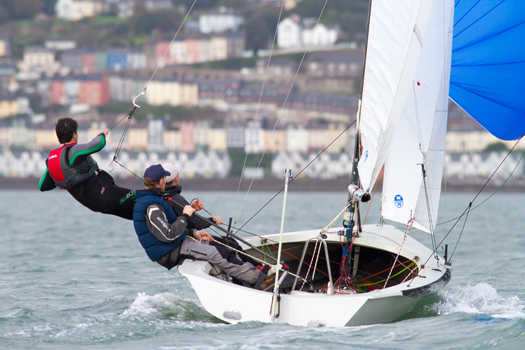
The big stories in Irish dinghy racing in 2015 will be the arrival of the new National 18s at Crosshaven, and the revival of Dinghy Week there in late August. Here, in the Autumn of 2013, To Dwyer and Nin O'Leary test sail the prototype of the new 18 on Cork Harbour. Photo: Bob Bateman
The new Third Generation (or maybe it's fourth or fifth generation) National 18 may have been designed in England by Phil Morrison, and is being built there too. But it was the very active Crosshaven fleet with the Royal Cork Yacht Club which led the charge towards a new boat, and when it came to stepping up to the plate to pay twelve substantial new boat deposits to move it all along after the prototype had been rigorously tested in Cork harbour last Autumn, it was the Crosshaven fleet that provided eight out of those twelve cheques.
So it's entirely appropriate that in August 2015, the dinghy focus will swing big time towards Crosshaven and a short form "Dinghy Week" from August 21st to 23rd. The old style Irish Dinghy Weeks – the last one was in 1970 – became victims of their own success, they just got too large. But the different classes became over-optimistic about their continuing individual growth prospects. Then the pendulum swung too far the other way, and dinghy classes were alone and their events shrinking. But a resurgence of club and championship dinghy sailing in Crosshaven during 2014, and a growing realization that over-reliance on single-handed dinghy classes does not necessarily produce a socially-adjusted national squad of junior sailors, resulted in some clear and creative thinking about developing two-handed boats, and reviving some old classes such as the Mirrors.
The form of this new Dinghy Week is still in the melting pot, but at least eight classes have responded with enthusiasm. Meanwhile, the National 18s in Crosshaven will be such a focus of interest during 2015 with the first of the new boats making their debut that we'll have a season-long dinghy narrative developing on Cork Harbour, and the revived Dinghy Week will be just part of it.
As for inshore keelboats, the big one in terms of number is the combined British and Irish Championship Squib Championship at Howth from 27th June to 3rd July. The handy little Squibs are something of an oddity, as they serve so well as a cherished local class in so many Irish sailing centres that many owners see them as that, and nothing more – handy little club sailors to be raced on home waters a couple of times a week.
This means that when a major regional or national event is held, the number taking part will often only be a fraction of the total Irish Squib fleet. But for those who do make the trek, the competition is fierce and the racing great – in Howth, the high point was in 1996, when this "Nationals" event attracted a fleet of exactly a hundred boats, and on one never-to-be-forgotten morning, there they were, every last one of them on the starting line.

A hundred Squibs all in a row at Howth on Tuesday July 25th 1996. Photo: Mandy Murnane
The most recent Squib event of national stature was the Freshwater Keelboat Regatta at Dromineer on Lough Derg on the weekend of October 18th-19th, and the battle for the top places was between the Kinsale and Belfast Lough fleets, with James Matthews and Rob Jacob of Kinsale rounding out their year in style with a good win.
But with the Squibs in England undergoing a revival – they were the second-biggest One Design fleet in Cowes Week 2014, bested only by the legendary XODs – there's no doubt there's a strong challenge coming across channel, and any Irish boat getting into the top ten will be doing well.
As for that annual Autumn Freshwater Keelboat Regatta at Dromineer, while it may have been much hampered by the spinoff from some ferocious weather out in the Atlantic with frustration for some of the sixty boats hoping to take part, it's an event of enormous potential, and the many who wish it well and have enjoyed it in the past will be ready and willing to do their part to make 2015's regatta a success.

The Squibs enjoying a lull in the strong winds during the Lough Derg Freshwater Regatta 2014. Overall winner was Mucky Duck (no 51, James Matthews & Rob Jacob, Kinsale YC). Photo: Gareth Craig
All these specialised and localized events planned for 2015 will be the continuing background music to the usual events of national sailing focus, everything from the selection of the Irish team for the Student Yachting Worlds to the Helmsmans Championships to the steady increase in pace while 2015 develops as the pre-Olympic year. As the year rolls along, other stories will develop too. So perhaps it's appropriate that we exit this review as we entered it. Just pause to remember now and again that, a hundred years ago, you simply couldn't have gone freely afloat like this for sport and recreation at all.
But we can't close on such a solemn note. Seasoned Solent sailors may have noted our header photo from Guido Cantini at the Panerai Classics Regatta was looking just slightly odd, for some reason difficult to pin down. Well, as it happens, the photo was sent to us back in September just as we were contemplating the excellent cleanup up done by Jason Hurley of Jason Hurley Design on the Mercedes-sponsored billboard photo of Howth 17s on the end wall of Howth Yacht Club. As with many photos taken over the RYS starting cannons, the Cantini pic included an obtrusive part of the Fawley Oil Refinery across on what Isle of Wight people call "the north island". Though Fawley has been there for yonks, it still has the look of a temporary structure. So we got Jason to treat as just that. But here for your edification is the true picture. You could get a taste for this sort of thing. What about brushing out Whitegate, lads? And as for Milford Haven.........
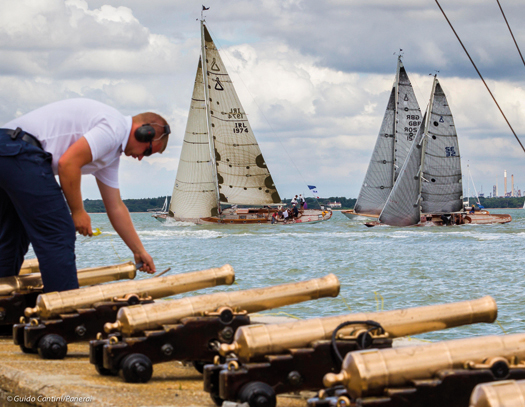
The unvarnished truth. In real life, the view from the RYS battery at Cowes can be slightly marred by the clutter of Fawley Refinery across the Solent on "the north island". Photo: Guido Cantini/Panerai
Read also: 2015 Irish Sailing Fixtures List (provisional)
Sutton Dinghy Club Pair Win Mirror National Championships
#mirror – The 2014 Mirror National Championships were held at a resplendent Sligo Yacht Club from August 7th to 10th. Twenty three Mirror Class Dinghies gathered for what proved to be an action packed four days of sailing on the enchanting waters of Sligo Bay.
The fleet faced very tricky sailing conditions over the four days in relatively light and shifty winds, not the norm for Sligo Bay. Conditions notwithstanding, the event was a major success with not a single general recall throughout the four days. A big thank you to all the competitors and families that made the trip to Sligo.
Shane Mcloughlin and his crew Oscar Langan from Sutton Dinghy Club mastered the conditions best, demonstrating some excellent sailing skills to take overall honours. Fast improving locals, Samuel and Imogen Wray took the honours in the silver fleet while Muiris Fitzgerald and Ellen O' Dwyer, also local, topped the bronze fleet.
Ten races were held over the four days. Forty six eager sailors set out on Thursday to do battle in hellishly tricky winds. One could not but have sympathy for OD Brendan Brogan as winds varied over 90 degrees, playing havoc with course laying. In the end, patience proved a virtue and Lough Ree's Tiernan Dickson took the first race with Shane Mc Loughlin and Jack Maye filling second and third spots. Lough Ree Yacht Club was again to the fore in the second race as the rapidly improving pair, Caolan Crossdell and Schull Harbour's very own Oisin MacAllister took line honours in a tight finish from Tiarnan Dickson and Alex Leech, in what was surely the performance of the weekend.
Day two was again frustrating for sailors as the shifting winds caused quite a few delays. Some sailors learned the hard way about the strong tides in Sligo Bay, while racing in the calm conditions. Shane McLoughlin from Sutton Dinghy Club turned the heat up, winning two races and finishing second in the last race to claim the overnight lead. Sligo's Beth Armstrong took the honours in the last race shooting right into contention behind Shane Mc Loughlin and the ever consistent Tiarnan Dickson. The two Jack's, Maye and Ryan kept their hopes up with a second place each.
Day three brought more shifty wind conditions to challenge the fleet. It was Tiarnan Dickson's turn to pile on the pressure with two wins and a third place finish. Ominously though, Shane Mcloughlin had two seconds and a win. The gap between the pair was just two points entering the final day. Beth Armstrong put in a very consistent shift and went into the last day right in contention should there be any slip ups.
Day four saw somewhat more consistent winds during which the final two races were sailed. Shane Mc Loughlin took the first from Beth Armstrong with Jack Maye in third. The final race turned into a local duel between cousins Beth Armstrong and Jack Maye, Jack taking an extended lead before Beth came through to take line honours and bring the shutters down on a thoroughly enjoyable 2014 National Championship.
And so it was, a splendid four days for the Mirror fleet soaked in the famous hospitality of Sligo Yacht Club. Those lucky enough to be present were reminded of the glory days of Irish sailing. Mingling with sailors, parents and club members, it was easy to understand how the Mirror Class has contributed so much to so many in Irish sailing down through the years.
Results:
Gold Fleet:-
1] Shane Mc Loughlin / Oscar Langan 12 points Sutton Dinghy Club [SDC]
2] Tiarnan Dickson / Alex Leech 18 points [LRYC]
3] Beth Armstrong / Dylan Shaw 20 points [SYC]
Silver Fleet:-
1] Samuel Wray / Imogen Wray [SYC]
2] Helen Smith / Noah Canham [SYC]
3] Rory Mc Allister / Lughaidh Croasdell [Schull Harbour & LRYC]
Bronze:-
I] Muiris Fitzgerald / Ellen O' Dwyer [SYC]
2] Sarah White / Matthew White [SYC]
3] Hannah Raftery / Ben Kelly [SYC]
The Mirror Dinghy's Famous Red Sails are Back at Royal Cork
#mirrordinghy – Record numbers attended the Mirror Southerns event at Royal Cork Yacht Club last weekend, 19 and 20 July 2014. 46 sailors in 23 boats – with helms ranging in age from 14 to 50+ and crew as young as five writes Celine McGrath.
Mirrors haven't sailed out of Royal Cork Yacht Club since 2005 and a few ex Mirror sailing members of the club, that have matured and have children of their own, decided it was time to dig out their old boats for some competitive family fun. There was some last minute sail swapping in the boat yard on Saturday morning and all boats, old and new, were ready for the first gun.
With changeable winds and changing tides the racing proved to be quite a challenge for the visiting boats, while the Royal Cork sailors knew their fate.
At the end of Saturdays racing Jack Maye and Shauna Armstrong from Sligo Yacht Club was leading by two points while our final overall winner was behind him by 5 points, so it was an open competition on Sunday.
The fluky winds and changing tides delayed Sunday's first race and went on to caus 9 sailors to not finish on the 2nd race and the 3rd race was cancelled due to time constraints.
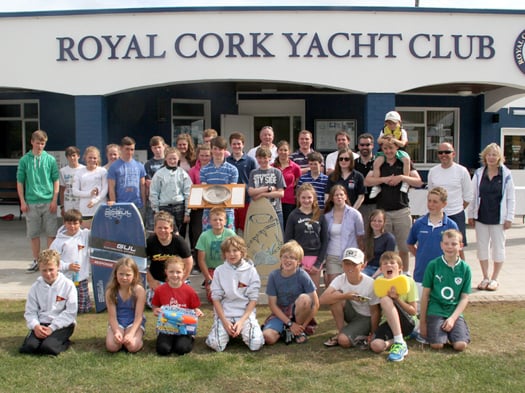
Mirror fleet winners at Royal Cork. Photo: Paul Keal
A fantastic BBQ hosted by Royal Cork Yacht Club on the Saturday night brought everyone together for some fun and talk of tactics and mirror construction. The "wood v's fibreglass" is always a hot one. There is no doubt the Windlass Mirror is a fine design, but a well balanced wooden boat can easy beat them hands down – a wooden boat from South Africa did win the Worlds in Lough Derg Yacht Club last year.
Royal Cork Yacht Club presented the most fantastic prizes of skim boards, boogie boards, sailing gloves and much more, while Oldest helm, Boat in most need of repair, Youngest Crew received a selection of fun prizes ranging from walking stick to rubber ring!
Results –
Gold and over all 1st. Mirror Sail No. 70428 from Sutton Dinghy Club. Helm Shane McLoughlin and Crew Oscar Langan
Gold 2nd. Mirror Sail No. 70622 from Lough Ree Yacht Club. Helm Tiarnan Dickson and Crew Alex Leech.
Gold 3rd. Mirror Sail No. 70580 from Sligo Yacht Club. Helm Beth Armstrong and Crew Luke McGrath of Royal Cork Yacht Club.
Silver 1st. Mirror Sail No. 70036 from Schull Harbour Sailing Club. Helm Rory MacAllister and Crew Lughaidh Croasdell of Lough Ree Yacht Club
Silver 2nd. Mirror Sail No. 69683 from Sligo Yacht Club. Helm Helen Smith and Crew Sarah Nicholson.
Bronze 1st. Mirror Sail No. 21645 from Royal Cork Yacht Club. Helm Richard McGinley and Kelly Williams – on their first ever Mirror event.
Is Optimist Competition Pushing Kids Too Hard?
#opti – As Ireland prepares to welcome a record fleet of youngsters to the Optimist dinghy European Championships in Dun Laoghaire in four months time, Afloat.ie reader David Quinn questions the level of intensity of this winter's training and asks is this developing a life long love for sailing, or creating the environment where a tiny minority can push for Olympic Glory, while the rest take up another sport?
I live close to the Harbour in Howth, County Dublin so I tend to walk the pier or drive past the Yacht Club most weekends. This winter, much more than previous years, I have become really bothered and concerned at the extent of winter junior training sessions, particularly with the Optimist Class.
I started sailing relatively late so don't have much knowledge or experience of the Optimist Class. I started out in Mirrors before moving to Standard Rig Lasers. We trained hard, as an informal group, in Howth and competed internationally, but this was only in our late teens and early twenties. It is noticeable how many of my peers from that time are still sailing now and have a great love for the sport. I put that down to the huge fun we had racing Mirrors in Sutton Dinghy Club and at Regional events.
The major issues facing our sport are the fall off in memberships, declining activity and the lack of youth members in our clubs. I think a close scrutiny of the Optimist class would go some way to explaining some of the underlying problems in our sport!
I don't have an exact count, but the Optimists must have done at least four intensive training weekends, each with six hours of training per day. I'm not involved in the class so I can't be certain of the timing or intensity, but they seemed to launch before 10am and finish at dusk most days. I'm sure they came in for lunch. Is this developing a life long love for sailing, or creating the environment where a tiny minority can push for Olympic Glory, while the rest take up another sport?
I know some in the ISA are very concerned with this level of intensity for such young sailors, but the class, driven by over-ambitious parents, takes no notice. I doubt this is developing a life-long love for the sport, and I doubt it is even encouraging the kids to become elite sailors.
Maybe 1/100 will make it to senior international funded sailing? I would love to see a wider debate on the subject? I know when I was in my teens I sailed Mirrors and had a ball. It wasn't exactly an elite pathway class, but most of my peers from those days still race and sail very actively 25 years later. There must be a lesson there and it would make for an interesting study?
David Quinn (40) is a Laser and SB20 Sportsboat sailor from Howth Yacht Club and a former racing manager of the ISA.



























